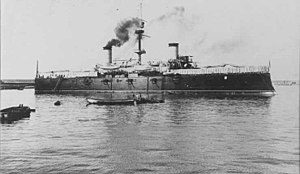Ulcoilo Crisis: Difference between revisions
old>Hippostania No edit summary |
Ozycaevias (talk | contribs) m (1 revision imported) |
Latest revision as of 18:02, 29 March 2019
This article is incomplete because it is pending further input from participants, or it is a work-in-progress by one author. Please comment on this article's talk page to share your input, comments and questions. Note: To contribute to this article, you may need to seek help from the author(s) of this page. |
| Ulcoilo Crisis | |||||||||
|---|---|---|---|---|---|---|---|---|---|
 The Aininian protected cruiser Marlane-la-Prairie underway off Ulcoilo during the crisis | |||||||||
| |||||||||
| Belligerents | |||||||||
|
|
| ||||||||
| Commanders and leaders | |||||||||
|
|
| ||||||||
| Strength | |||||||||
|
Deployed forces 56 marines, 1 protected cruiser Mobilised reinforcements 15,500 personnel, 31 warships |
Deployed forces 40 soldiers, 1 field gun, 1 sloop-of-war Mobilised reinforcements 7,000 personnel, 17 warships | ||||||||
The Ulcoilo Crisis (French: Crise de l'isle d'Ulco, Mespalian: Ulcoilon crîse) was a confrontation between Ainin and Mespalia over Ainin's plans to create a coastal fort emplacement on Ulcoilo, a divided island in the centre of the Strait of Mespalia. The dispute started after the Aininian Navy announced plans to build a Girouette naval gun position on the island facing towards Ainin to improve its ability to deny enemies access to the waterway in the event of war. The announcement was met with indignation in Mespalia, as it laid claim to the entire island of Ulcoilo and saw the gun position as a threat to its own shipping in the strait.
In response, Mespalian troops were deployed onto its side of the island to supervise the construction of the battery, leading to a reciprocal Aininian deployment. With neither side backing down, both nations began reinforcing their garrisons on the island, with the Aininian deployment of the protected cruiser Marlane-la-Prairie being met by the creation of Mespalian field artillery placements. The situation continued to simmer over the summer and a war scare swept both nations, with thousands of Royal Mespalian Army personnel and Aininian Republican Guards being pre-emptively mobilised in the expectation of a conflict over Ulcoilo.
The situation was only defused in September, when Aininian president Lucien Passereau met Mespalian Minister of State Costia Tœviliacca in Saint-Rémy, Nouvelle Verquinte to resolve the dispute. In the subsequent Convention of Saint-Rémy, Ainin and Mespalia agreed to remove their respective garrisons and declare Ulcoilo to be a demilitarised zone in perpetuity. In a concession to the original Aininian plans, the agreement permitted the construction of a coaling station on the Aininian half of the island that remained in operation until 1922. The crisis also created the impetus for the 1883 establishment of the Joint Strait Commission to peacefully resolve future disputes in the Strait of Mespalia and assume joint administration of fishing quotas and navigation rights.
Background
Ulcoilo was known in Antiquity, featuring on navigation charts from the Latin Republic era. While several attempts at settlement were made over the years, the sovereignty of the island was never an issue until 1806, as Mespalia was a semi-autonomous viceroyalty governed by the Aininian minority during the Kingdom of Ainin era and after the Aininian Revolution, a governorate ruled by republicans from the Ainin proper. After Mespalia gained independence in 1806, control of the island and surrounding waters was disputed between the neighbours until 1833, when diplomatic notes were exchanged accepting an maritime border runs through the island, effectively bisecting it in half.
While the 1833 memoranda solved outstanding territorial disputes, Aininian-Mespalian relations remained fairly frosty throughout the 19th century due to the circumstances of Mespalia's separation from Ainin and a mutual distrust of each other's government systems. Mespalian immigration to West Ainin and Linaque over the 19th century also fuelled xenophobia and anti-Mespalian sentiment in Northern Ainin, resulting in the election of a large number of nativist politicians to the National Assembly who would lead the way in agitating for war during the Crisis. Meanwhile, a 1877 report commissioned by the War Ministry identified major flaws in Ainin's sea lane defence, which caused widespread concern in the National Assembly. Faced with negative press coverage and legislative pressure, President Passereau's administration undertook a scheme to resolve the "blind spot" that the report had identified in the Strait by building a gun emplacement.
